NCERT Solutions | Class 8 Maths Chapter 3 | Understanding Quadrilaterals

CBSE Solutions | Maths Class 8
Check the below NCERT Solutions for Class 8 Maths Chapter 3 Understanding Quadrilaterals Pdf free download. NCERT Solutions Class 8 Maths were prepared based on the latest exam pattern. We have Provided Understanding Quadrilaterals Class 8 Maths NCERT Solutions to help students understand the concept very well.
NCERT | Class 8 Maths
| Book: | National Council of Educational Research and Training (NCERT) |
|---|---|
| Board: | Central Board of Secondary Education (CBSE) |
| Class: | 8th |
| Subject: | Maths |
| Chapter: | 3 |
| Chapters Name: | Understanding Quadrilaterals |
| Medium: | English |
Understanding Quadrilaterals | Class 8 Maths | NCERT Books Solutions
NCERT Solutions for Class 8 Maths Chapter 3 Understanding Quadrilaterals Exercise 3.1
Ex 3.1 Class 8 Maths Question 1.
Given here are some figures :
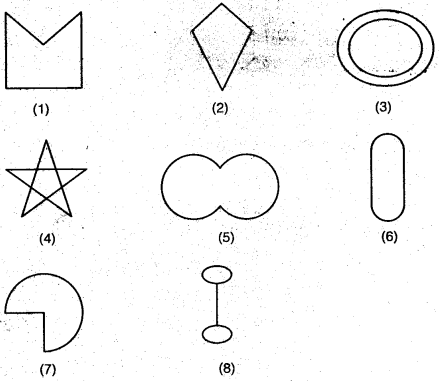
Classify each of them on the basis of the following :
(a) Simple curve
(b) Simple closed curve
(c) Polygon
(d) Convex polygon
(e) Concave polygon
Solution:
The classification of the given figures is as under :(a) Simple curve : (1), (2), (5), (6), (7) and (8)
(b) Simple closed curve : (1), (2), (5), (6) and (7)
(c) Polygon: (1) and (2)
(d) Convex polygon : (2)
(e) Concave polygon : (1) and (4)
Ex 3.1 Class 8 Maths Question 2.
How many diagonals does each of the following have?(a) A convex quadrilateral
(b) A regular hexagon
(c) A triangle.
Solution:
(a) A convex quadrilateral has two diagonals.(b) A regular hexagon has nine diagonals.
(c) A triangle has no diagonal.
Ex 3.1 Class 8 Maths Question 3.
What is the sum of the measures of the angles of a convex quadrilateral? Will this property hold if the quadrilateral is not convex? (Make a non-convex quadrilateral and j try!)Solution:
The sum of measures of the angles of a convex quadrilateral is 360°. Yes, this property holds in case of the quadrilateral is not convex.Ex 3.1 Class 8 Maths Question 4.
Examine the table. (Each figure is divided into triangles and the sum of the angles deduced from that.)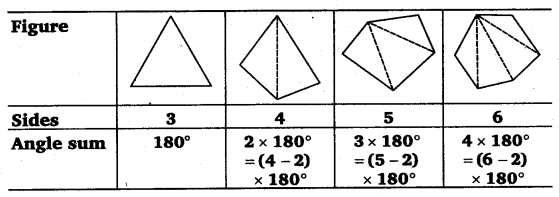
What can you say about the angle sum of a convex polygon with number of sides?
(a) 7
(b) 8
(c) 10
(d) n
Solution:
From the given table, dearly we observe that the sum of angles (interior angles) of a polygon with n sides = (n – 2) x 180°.(a) n = 7
∴ The sum of the angles of a polygon of 7 sides
Angle sum = \(\left( 7-2 \right) \times { 180 }^{ \circ }\)
= \(5\times { 180 }^{ \circ }={ 900 }^{ \circ }\)
(b) n = 8
∴ The sum of the angles of a polygon of 8 sides
Angle sum = \(\left( 8-2 \right) \times { 180 }^{ \circ }\)
= \(6\times { 180 }^{ \circ }={ 1080 }^{ \circ }\)
(c) n = 10
∴ The sum of the angles of a polygon of 10 sides
Angle sum = \(\left( 10-2 \right) \times { 180 }^{ \circ }\)
= \(8\times { 180 }^{ \circ }={ 1440 }^{ \circ }\)
(d) Clearly from the given table it is observed that the number of triangles is two less them the number of sides in the polygon.
∴ If the polygon has n sides, the number of triangles formed will be (n – 2).
Since the sum of angles of a triangle = 180°
∴ The sum of angles of a polygon of n sides = (n – 2) x 180°.
Ex 3.1 Class 8 Maths Question 5.
What is a regular polygon? State the name of a regular polygon of(i) 3 slides
(ii) 4 slides
(iii) 6 slides
Solution:
A polygon is said to be a regular polygon, if all its- interior angles are equal;
- sides are equal; and
- exterior angles are euqal.
The name of a regular polygon of
- 3 sides is equilateral triangle.
- 4 sides is square.
- 6 sides is regular hexagon.
Ex 3.1 Class 8 Maths Question 6.
Find the angle measure x in the following figures.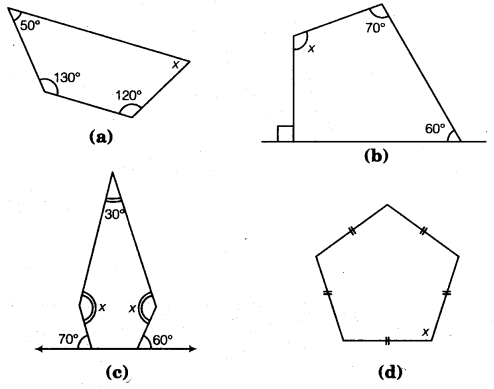
Solution:
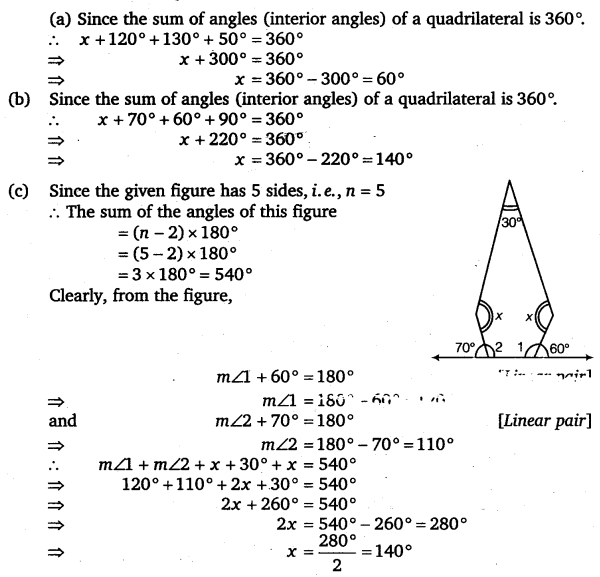
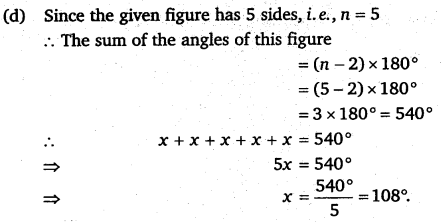
Ex 3.1 Class 8 Maths Question 7.
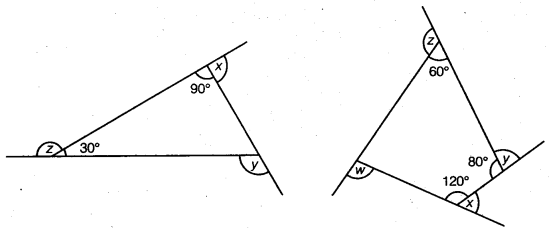
(a) Find x + y + z
(b) Find x + y + z + w.
Solution:
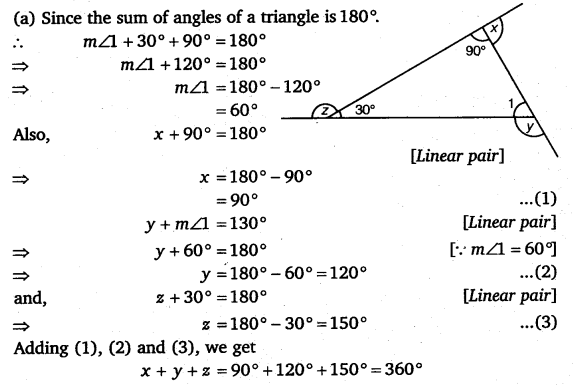
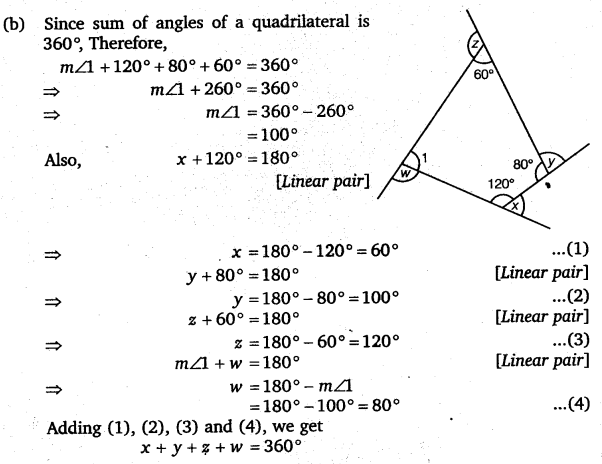
NCERT Solutions for Class 8 Maths Chapter 3 Understanding Quadrilaterals Exercise 3.2
Ex 3.2 Class 8 Maths Question 1.
Find x in the following figures.
Solution:
We know that the sum of the exterior angles formed by producing the sides of a convex polygon in the same order is equal to 360°. Therefore,(a) x + 125° + 125° = 360°
⇒ x + 250° = 360°
⇒ x = 360° – 250° = 110°
(b) x + 90° +60° + 90° + 70° = 360°
⇒ x + 310° = 360°
⇒ x = 360° – 310° = 50°
Ex 3.2 Class 8 Maths Question 2.
Find the measure of each exterior angle of a regular polygon of(i) 9 sides
(ii) 15 sides
Solution:
(i) Each exterior angle of a regular polygon of 9 sides
(ii) Each exterior angle of a regular polygon of 15 sides

Ex 3.2 Class 8 Maths Question 3.
How many sides does a regular polygon have if the measure of an exterior angle is 24°?Solution:
Since the number of sides of a regular polygon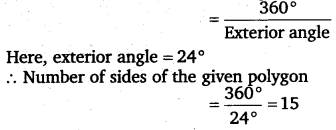
Ex 3.2 Class 8 Maths Question 4.
How many sides does a regular polygon have if each of its interior angles is 165°?Solution:
Let there be n sides of the polygon. Then, its each interior angle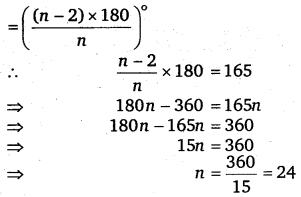
Thus, there are 24 sides of the polygon.
Ex 3.2 Class 8 Maths Question 5.
(a) Is it possible to have a regular polygon with measure of each exterior angle as 22°?(b) Can it be an interior angle of a regular polygon ? Why?
Solution:
(a) Since the number of sides of a regular polygon
= \(\frac { 180 }{ 11 } \),
Which is not a whole number.
A regular polygon with measure of each exterior angle as 22° is not possible.
(b) If interior angle = 22°, then its exterior angle = 180° – 22° = 158°.
But 158 does not divide 360 exactly.
Hence, the polygon is not possible.
Ex 3.2 Class 8 Maths Question 6.
(a) What is the minimum interior angle possible for a regular polygon? Why?(b) What is the maximum exterior angle possible for a regular polygon?
Solution:
(a) The equilateral triangle being a regular polygon of 3 sides has the least measure of an interior angle = 60°.(b) Since the minimum interior angle of a regular polygon is equal to 60°, therefore, the maximum exterior angle possible for a regular polygon = 180° – 60° – 120°.
NCERT Solutions for Class 8 Maths Chapter 3 Understanding Quadrilaterals Exercise 3.3
Ex 3.3 Class 8 Maths Question 1.
Given a parallelogram ABCD. Complete each statement along with the definition with the definiton or property used.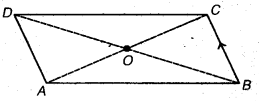
(i) AD = ………
(ii) ∠DCB = …………….
(iii) OC = ……………….
(iv) m∠DAB + m∠CDA = …………..
Solution:
(i) AD = BC : In a parallelogram, opposite sides are euqal.(ii) ∠DCB = ∠DAB : In a parallelogram, opposite angles are equal.
(iii) OC = OA : The diagonals of a parallelogram bisect each other.
(iv) m∠DAB + m∠CDA = 180° : In a parallelogram, the stun of any two adjacent angles is 180°.
Ex 3.3 Class 8 Maths Question 2.
Consider the following parallelograms. Find the values of the unknowns x, y, z.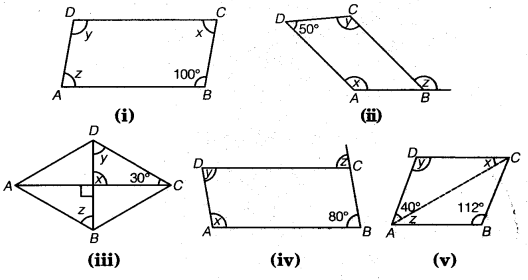
Solution:
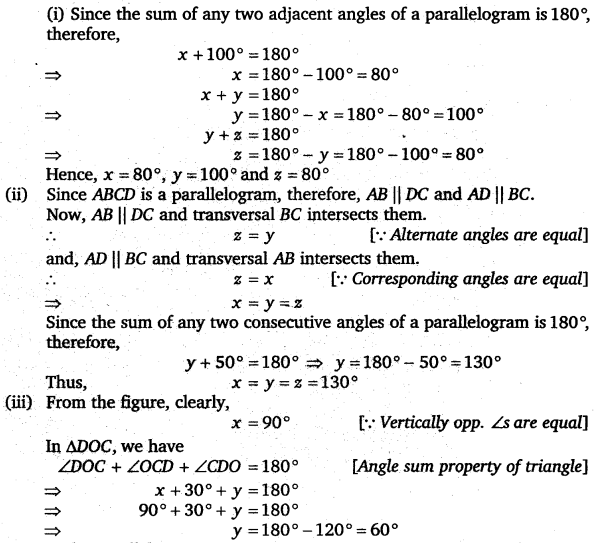
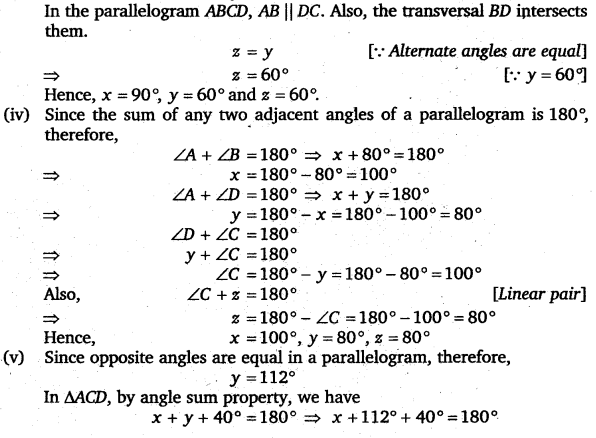

Ex 3.3 Class 8 Maths Question 3.
Can a quadrilateral ABCD be a parallelogram if(i) ∠D + ∠B = 180° ?
(ii) AB = DC = 8 cm, AD = 4 cm and BC = 4.4 cm
(iii) ∠A = 70° and ∠C = 65°?
Solution:
(i) If in a quadrilateral ABCD, ∠D + ∠B = 180°, then it is not necessary that ABCD is a parallelogram.(ii) Since AD ≠ BC, i.e., the opposite sides are unequal, so ABCD is not a parallelogram.
(iii) Since ∠A ≠ ∠C, i.e., the opposite angles are unequal, so ABCD is not a parallelogram.
Ex 3.3 Class 8 Maths Question 4.
Draw a rough figure of a quadrilateral that is not a parallelogram but has exactly two opposite angles of equal measure.Solution:

A rough figure of a quadrilateral ABCD that is not a parallelogram has been drawn with exactly two opposite angles of equal measure such that ∠A – ∠C which is a kite as an example.
Ex 3.3 Class 8 Maths Question 5.
The measures of two adjacent angles of a parallelogram are in the ratio 3 :2. Find the measure of each of the angles of the parallelogram.Solution:
Let two adjacent angles A and B of ||gm ABCD be 3x and 2x respectively.Since the adjacent angles of a parallelogram are supplementary.
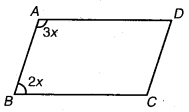
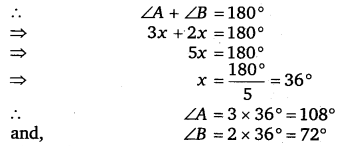
Since the opposite angles are equal in a parallelogram, therefore,
∠C = ∠A = 108° and ∠D = ∠B = 72°
Hence, ∠A = 108°, ∠B = 72°, ∠C = 108° and ∠D = 72°.
Ex 3.3 Class 8 Maths Question 6.
Two adjacent angles of a parallelogram have equal measure. Find the measure of each of the angles of the parallelogram.Solution:
Let two adjacent angles A and B of parallelogram ABCD be x each.Since the adjacent angles of a parallelogram are supplementary.

Ex 3.3 Class 8 Maths Question 7.
The adjacent figure HOPE is a parallelogram. Find the angle measures x, y and z. State the properties you use to find them.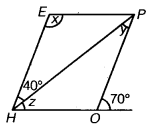
Solution:
Since HOPE is a parallelogram, therefore, HE || OP and HO || EP.Now, HE || OP and transversal HO intersects them.
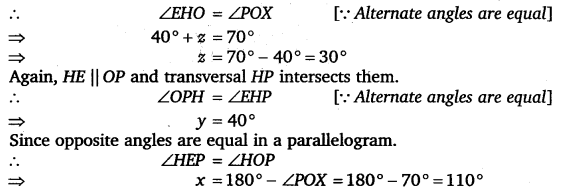
Hence, x = 110°, y = 40° and z = 30°
Ex 3.3 Class 8 Maths Question 8.
The following figures GUNS and RUNS are parallelograms. Find x and y. (Lengths are in cm)
Solution.
(i) Since GUNS is a parallelogram, therefore, its opposite sides are equal.

(ii) In a parallelogram, diagonals bisect each other, therefore,

Ex 3.3 Class 8 Maths Question 9.
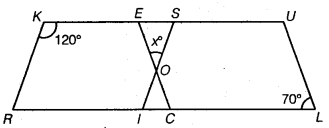
In the below figure both RISK and CLUE are parallelograms. Find the value of x.
Solution:
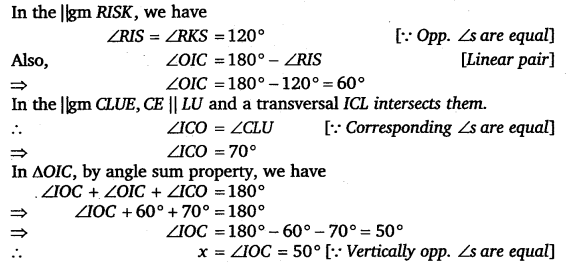
Ex 3.3 Class 8 Maths Question 10.
Explain how this figure is a trapezium. Which of its two sides are parallel ?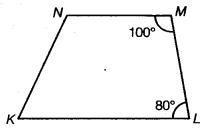
Solution:
Since ∠KLM + ∠NML = 180° i.e., the pair of consecutive interior angles are supplmentary.Therefore, KL || NM and so KLMN is a trapezium.
Ex 3.3 Class 8 Maths Question 11.
Find m∠C in the figure, if \(\overline { AB } \) || \(\overline { DC } \).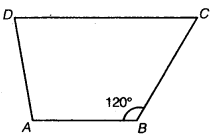
Solution:
Since AB || DC and transversal BC intersectsthem.
∠B + ∠C= 180°
[∵ Sum of interior angles is 180°]
⇒ 120°+ ∠C =180° A
⇒ ∠C = 180°- 120° = 60°
Hence, m∠C =60°
Ex 3.3 Class 8 Maths Question 12.
Find the measure of ∠P and ∠S, if \(\overline { SP } \) || \(\overline { RQ } \) in the figure. (If you find mZ R, is there more than one method to find m∠P ?)
Solution:
Since SP || RQ and PQ is a transversal intersecting them at P and Q.∴ ∠P + ∠Q =180°
[∵ Sum of interior angles is 180°]
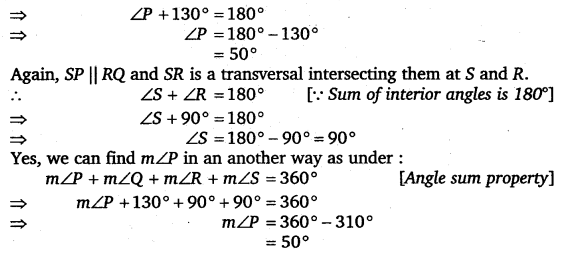
NCERT Solutions for Class 8 Maths Chapter 3 Understanding Quadrilaterals Exercise 3.4
Ex 3.4 Class 8 Maths Question 1.
State whether True or False :(a) All rectangles are squares
(b) All rhombuses are parallelograms
(c) All squares are rhombuses and also rectangles
(d) All squares are not parallelograms
(e) All kites are rhombuses
(f) All rhombuses are kites
(g) All parallelograms are trapeziums
(h) All squares are trapeziums.
Solution:
(a) False(b) True
(c) True
(d) False
(e) False
(f) True
(g) True
(h) True
Ex 3.4 Class 8 Maths Question 2.
Identify all the quadrilaterals that have.(a) four sides of equal length
(b) four right angles
Solution:
(a) The quadrilaterals having four sides of equal length is either a square or a rhombus. ,(b) The quadrilaterals having four right angles is either a square or a rectangle.
Ex 3.4 Class 8 Maths Question 3.
Explain how a square is(i) a quadrilateral
(ii)a parallelogram
(iii) a rhombus
(iv) a rectangle.
Solution:
(i) A square is 4 sided, so it is a quadrilateral.(ii) A square has its opposite sides parallel, so it is a parallelogram.
(iii) A square is a parallelogram with all the four sides equal, so it is a rhombus.
(iv) A square is a parallelogram with each angle a right angle, so it is a rectangle.
Ex 3.4 Class 8 Maths Question 4.
Name the quadrilaterals whose diagonals :(i) bisect each other
(ii) are perpendicular bisectors of each other
(iii) are equal.
Solution:
(i) The quadrilaterals whose diagonals bisect each other can be a parallelogram or a rhombus or a square or a rectangle.(ii) The quadrilaterals whose diagonals are perpendicular bisectors of each other can be a rhombus or a square.
(iii) The quadrilaterals whose diagonals are equal can be a square or a rectangle.
Ex 3.4 Class 8 Maths Question 5.
Explain why a rectangle is a convex quadrilateral.Solution:
Since the measure of each angle is less than 180° and also both the diagonals of a rectangle he wholly in its interior, so a rectangle is a convex quadrilateral.Ex 3.4 Class 8 Maths Question 6.
ABC is a right-angled triangle and O is the mid-point of the side opposite to the right angle. Explain why O is equidistant from A, B and C. (The dotted lines are drawn additionally to help you).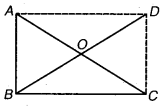
Solution:
Produce BO to D such that BO = OD. Join AD and DC. Then ABCD is a rectangle. In the rectangle ABCD, its diagonals AC and BD are equal and bisect each other at O.∴ OA = OC and OB = OD.
But AC = BD
Therefore, OA = OB = OD
Thus, O is equidistant from A, B and C.
NCERT Class 8 Maths
Class 8 Maths Chapters | Maths Class 8 Chapter 3
NCERT Solutions for Class 8 Maths
NCERT Solutions of Maths Class 8 Chapter-wise
Chapter-wise NCERT Solutions for Class 8 Maths
-
NCERT Solutions For Class 8 Maths Chapter 1 Rational Numbers
NCERT Solutions For Class 8 Maths Chapter 2 Linear Equations in One Variable
NCERT Solutions For Class 8 Maths Chapter 3 Understanding Quadrilaterals
NCERT Solutions For Class 8 Maths Chapter 4 Practical Geometry
NCERT Solutions For Class 8 Maths Chapter 5 Data Handling
NCERT Solutions For Class 8 Maths Chapter 6 Squares and Square Roots
NCERT Solutions For Class 8 Maths Chapter 7 Cubes and Cube Roots
NCERT Solutions For Class 8 Maths Chapter 8 Comparing Quantities
NCERT Solutions For Class 8 Maths Chapter 9 Algebraic Expressions and Identities
NCERT Solutions For Class 8 Maths Chapter 10 Visualising Solid Shapes
NCERT Solutions For Class 8 Maths Chapter 11 Mensuration
NCERT Solutions For Class 8 Maths Chapter 12 Exponents and Powers
NCERT Solutions For Class 8 Maths Chapter 13 Direct and Indirect proportions
NCERT Solutions For Class 8 Maths Chapter 14 Factorisation
NCERT Solutions For Class 8 Maths Chapter 15 Introduction to Graphs
NCERT Solutions For Class 8 Maths Chapter 16 Playing with Numbers
NCERT Solutions for Class 6 to 12
-
NCERT Solutions for Class 6 All Subjects
NCERT Solutions for Class 7 All Subjects
NCERT Solutions for Class 8 All Subjects
NCERT Solutions for Class 9 All Subjects
NCERT Solutions for Class 10 All Subjects
NCERT Solutions for Class 11 All Subjects
NCERT Solutions for Class 12 All Subjects

Post a Comment
इस पेज / वेबसाइट की त्रुटियों / गलतियों को यहाँ दर्ज कीजिये
(Errors/mistakes on this page/website enter here)